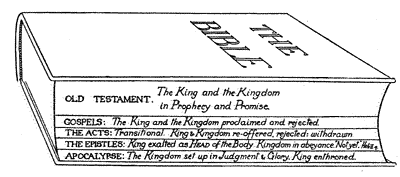The one great subject which runs through the whole Word of God is Christ: the promised seed of the woman in Gen. 3:15.
This verse marks the depth of the ruin into which man had descended in the Fall; and it becomes the foundation of the rest of the Bible.
All hope of restoration for man and for creation is centred in Christ; who in due time should be born into the world, should suffer and die; and, in resurrection, should become the Head of a new creation, and should finally crush the head of the Old Serpent, who had brought in all the ruin. Christ, therefore, the King, and the Kingdom which He should eventually set up, become the one great subject which occupies the whole of the Word of God.
Hence, He is the key to the Divine revelation in the Word; and apart from Him it cannot be understood.
The contents of the Bible must therefore be seen and arranged with reference to Him. The counsels and purposes of God are all centred in Christ.
- In the Old Testament we have the King and the Kingdom in Promise and Prophecy, Illustration and Type.
- In the Four Gospels we have the King and the Kingdom presented and proclaimed by John the Baptiser, and by Christ Himself. And we see the Kingdom rejected, and the King crucified.
- In the Acts of the Apostles we have the Transition from the Kingdom to the Church. The Kingdom is once again offered to Israel by Peter; again it is rejected, Stephen is stoned, and Peter imprisoned (ch. 12.).
Then Paul, who had been already chosen and called (ch. 9.), is commissioned for His Ministry (ch. 13.), and on the final rejection of his testimony concerning the Kingdom, he pronounces for the third and last time the sentence of judicial blindness in Isaiah 6, and declares that “the salvation of God is sent to the Gentiles” (Acts 28:25-28).
In his final communication to Hebrew believers it is written that while in God’s counsels all things had been put under Christ’s feet, “we see NOT YET all things put under Him ” (Heb. 2:7-9).
The Kingdom thenceforth is in abeyance. - In the Epistles we have the King exalted, and (while the Kingdom is in abeyance) made the Head over all things to the Church, during this present Interval; the Dispensation of the grace of God.
- In the Apocalypse we have the Revelation of the King in judgment; and we see the Kingdom set up, the King enthroned in power and glory, the promise fulfilled, and prophecy ended.
We may exhibit the above to the eye in the following Structure:
- A. The King and the Kingdom in Promise and Prophecy. (The Old Testament.)
- B. The King presented, proclaimed, and rejected. The Mysteries (or Secrets) of the Kingdom revealed. Matt. 13:11, 34, 35. (The Four Gospels.)
- C. Transitional (The Acts). The Kingdom again offered and rejected. The Mystery of the Church made known. The Kingdom in abeyance (Heb. 2:8).
- B. The King exalted and made Head over all things to the Church, “which is His body, the fulness of Him that filleth all in all ” (Eph. 1:22, 23). The Great Mystery completed (The Epistles).
- A. The King and the Kingdom unveiled. The King enthroned, and the Kingdom set up with Divine judgment, power, and glory (Rev. 19, 20). Promise and prophecy fulfilled (The Apocalypse).

Here the correspondence is seen between these five members.
In A and A we have the King and the Kingdom.
In B and B we have the King and the mysteries (or secrets) of the Kingdom (Matt. 13).
In C, the central member, we have the present Interval, while the King is absent, the Holy Spirit present, and the Kingdom in abeyance, and the mystery of the Church revealed (Eph. 3).
From the Structure it will be seen that the great subject of the whole Book is one. From Gen. 3:15 to Rev. 22., “THE COMING ONE” fills our vision.
This teaches us that the Coming of Christ is no newly invented subject of some modern faddists or fanatics, or cranks; but that Christ’s coming has always been the Hope of His people.
In “the fulness of time” He came: but having been rejected and slain He rose from the dead, and ascended to Heaven. There He is “seated” and “henceforth expecting until His enemies shall be placed as a footstool for His feet ” (Heb. 10:13).
Hence, Christ, “the Coming One,” is the one all-pervading subject of the Word of God as a whole.
He is the pneuma or life-giving spirit of the written Word, without which the latter is dead. “As the body without the pneuma is dead” (Jas. 2:26), so the written Word without the pneuma is dead also. Christ is that pneuma or spirit. This is the whole argument of II Cor. 3.
This is why the Lord Jesus could say of the Scriptures: “They testify of ME” (John 1:45; 5:39; Luke 24:44, 45).
Their one great design is to tell of the Coming One. All else is subordinated to this. This is why we see the ordinary events in a household combining with the grandest visions of a prophet to testify of Him who fills all Scripture. It may be said of the written Word, as it is of the New Jerusalem, “The Lamb is the light thereof ” (Rev. 21:23).
Apart from Him, the natural eye of man sees only outward historical details and circumstances; some in themselves appearing to him trifling, others offensive, and pursued at a length which seems disproportionate to the whole; while things which “angels desire to look into” are passed over in a few words, or in silence.
But once let “the spiritual mind” see Christ testified of “in Moses and all the prophets,” then all assumes a new aspect: trifles that seem hardly worth recording fill the whole vision and light up the written Word and make it to shine with the glory of the Divine presence.
Then we see why the Inspired writer dwells on a matter which to the outward eye seems trivial compared with other things which we may deem to be of world-wide importance.
Then we observe in an event, seemingly casual and unimportant, something which tells forth the plans and counsels of God, by which He is shaping everything to His own ends. Nothing appears to us then either great or small. All is seen to be Divine when the Coming One is recognized as the one subject of the Word of God.
This is the master-key of the Scriptures of truth.
“These are they that testify of ME.” Bearing this key in our hand we can unlock the precious treasures of the Word; and understand words, and hints; apparently casual expressions, circumstances, and events, which in themselves, and apart from Him, are meaningless.
It is the use of this master-key and this first great foundation principle which is to be observed in the study of the “Word” and “words” of God. It is when we, in every part, have found “HIM of whom Moses in the law, and the prophets, did write” (John 1:45), that we can understand those parts of Scripture which are “a stone of stumbling and a rock of offence” to many; that we can explain much that is otherwise difficult; see clearly much that before was obscure; answer objections that are brought against the Word; and “put to silence the ignorance of foolish men.”
The moment this master-key is used types will be seen foreshadowing the Coming King, and showing forth His sufferings and His Glory. Events and circumstances will show forth His wondrous deeds and tell of the coming glory of His kingdom.
The Bible text in this publication, except where otherwise indicated, is from the King James Version. This article appears on the site: http://peterwade.com/.



Leave A Comment